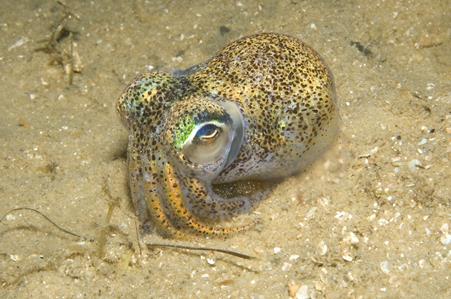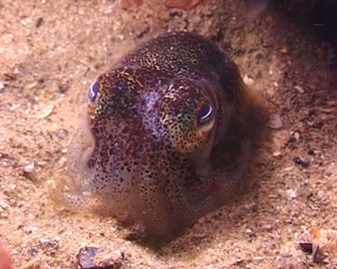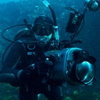Other Names
- Southern Dumpling Squid
General Description
Small round, bottom living squid. Large pair of rounded fins on sides of body encompassing the rear two thirds of the body. Iridescent green in colour with large dark brown spots (chromatophores) scattered over the body, head and arms. Mantle cavity (underneath the body) contains a large, butterfly-shaped light organ. Mantle length to 4 cm.
Biology
These small squids bury in the sand during the day, emerging at night to hunt for small shrimp and fish. The skin on the upper head and body of this squid is covered in mucous glands that can be used to glue a coat of sand over the whole animal. This allows the squid to remain camouflaged against the sand background. At night this squid uses a light organ in its gill cavity to cancel its silhouette. The light organ contains special glowing bacteria that are fed sugars by the squid in return for making light. By cancelling its silhouette the squid is able to remain undetected as it swims above upward-looking predators. Females lay round orange-cream eggs in clumps.
Habitat
Sand and mud habitats in shallow coastal waters, often near seagrass beds to a depth of at least 144 m.
Seagrass meadows
Soft substrates
Distribution guide
Southern Australia.
Species Group
Depth
Shallow (1-30 m)
Deep ( > 30 m)
Water Column
Max Size
4 cm
Diet
Carnivore
Harmful
Potential to bite, especially if handled. Venom status unknown.
Commercial Species
No
Global Dispersal
Native to Australia
Identify
Conservation Status
- DSE Advisory List : Not listed
- EPBC Act 1999 : Not listed
- IUCN Red List : Not listed










